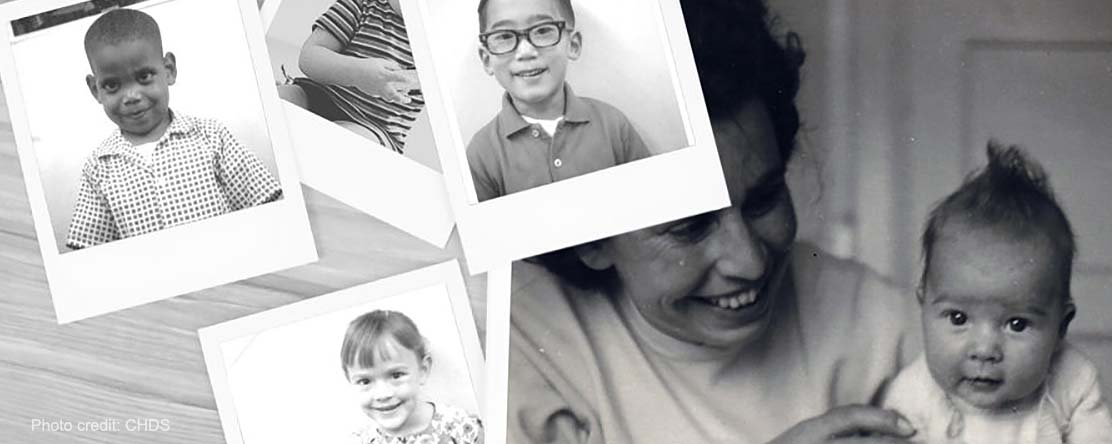
In the News
What Three Generations of California Families Can Tell Us About the Links Between Our Health and Our Environment
-
Focus Areas
Environmental Health, Women, Youth & Children

A decades-long study offers valuable insights into the relationship between the environment in which we live and cancer, autoimmune diseases and other disorders.
May 16, 2019—Ruth Deuel was a computer programmer at the University of California, Berkeley, when she became pregnant with her second child in 1961. Deuel, who always had shown an aptitude for math, didn’t think twice when asked to participate in a health study at the Kaiser Permanente hospital in Oakland where her daughter, Jennifer, was born in February 1962.
“I didn’t want to be one of those missing data items that are the bane of every scientist’s existence,” remembers Deuel, now 85.
Deuel is one of more than 15,000 northern California women who voluntarily joined the Berkeley-based Child Health and Development Studies (CHDS) between 1959 and 1967, shortly before giving birth. The expectant mothers were a cross-section of San Francisco Bay–area culture in the 1960s. They were civil rights activists, hippies, intellectuals, students, farmworkers, nurses, newspaper reporters and housewives; white and black, Latino- and Asian-American. Each contributed vials of blood, urine and saliva and completed extensive interviews about health and lifestyle factors that could influence the progress of pregnancy and infant development.
Now in its seventh decade, the CHDS is one of the world’s longest running and likely one of the most diverse familial health studies. Deuel’s family and others have contributed invaluable data—the health of these women, their children and their grandchildren has been chronicled in hundreds of scientific papers. These studies are poised to help answer some of the most vexing questions about the impact of environment on our health.
Early Exposures, Later Diseases
Our risk of developing many common ailments—including cancer, diabetes, heart disease, obesity, dementia and inflammatory autoimmune disorders—can be chalked up to a combination of our unique genetic susceptibilities and a slew of external factors that influence the environment in which we live. Researchers agree that it’s important to determine what these external factors are—and what role they play in the development of a given disease—because, unlike our genes, we can theoretically change things in our environment that heighten disease risk.
But teasing out the role of environment has proved more complicated than simply identifying the behaviors, stressors and exposures that make up a person’s lifestyle and environment at the time of illness. Researchers are increasingly realizing that we’re more vulnerable to environmental changes and exposures during some life stages than others. Our environment before we’re born now appears critically important in predicting disease later on. In many cases, the long lag time between exposure and symptoms makes it extremely difficult to study—and prove—the link between environment and ill health.
Long-running studies in which scientists collect data from a group of people at different points over the course of their lives are one way around that. In fact, these so-called “cohort studies” are among the best tools scientists have for finding and substantiating links between environmental exposures in early life and long-term health outcomes, says Suzanne Fenton, a reproductive endocrinologist at the National Institute of Environmental Health Sciences in Research Triangle Park, North Carolina.
Gathering Data
Andrea Hesse, now 59, vaguely recalls her mother taking her to a second-story walk-up in her hometown of Berkeley, California, when she was 6 or 7 years old. There, other adults watched her put together puzzle pieces. While the memory seems a bit odd now, there would have been nothing unusual about it at the time, says Hesse. Contributing to the social good through experimentation in education and other areas of civic life, seemed the norm to her at the time. “And this study felt like a part of that,” she says.
Later on, in young adulthood, and again in her 30s or 40s, she answered questions in interviews about her health habits. Hesse’s mother joined the CHDS while pregnant with her in 1960. Researchers have been collecting and preserving data from Hesse and other “second generation” study participants since before birth. As these kids grew older, the type of questions that researchers could address with the data became more complex.
Originally published by Ensia
More Updates


Safeguarding the Health and Wellbeing of Agricultural Workers in Monterey County: A 5-Year Glance at the COVID Pandemic & Lessons Learned

New Study Reveals Why Alcohol Use Increased During the Pandemic

PHIL Collective: Tools, Training and Resources for Collaborative, Cross-Sector Efforts to Improve Health and Equity
Work With Us
You change the world. We do the rest. Explore fiscal sponsorship at PHI.
Support Us
Together, we can accelerate our response to public health’s most critical issues.
Find Employment
Begin your career at the Public Health Institute.
